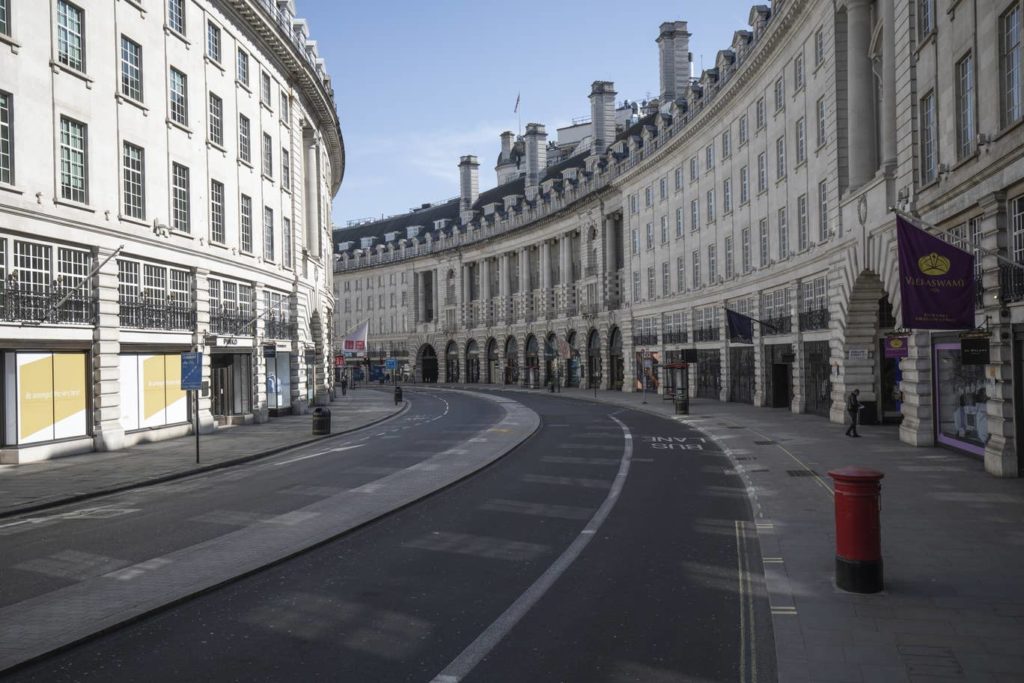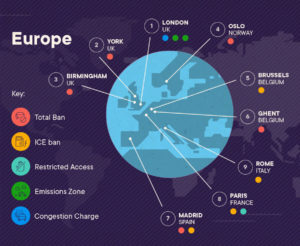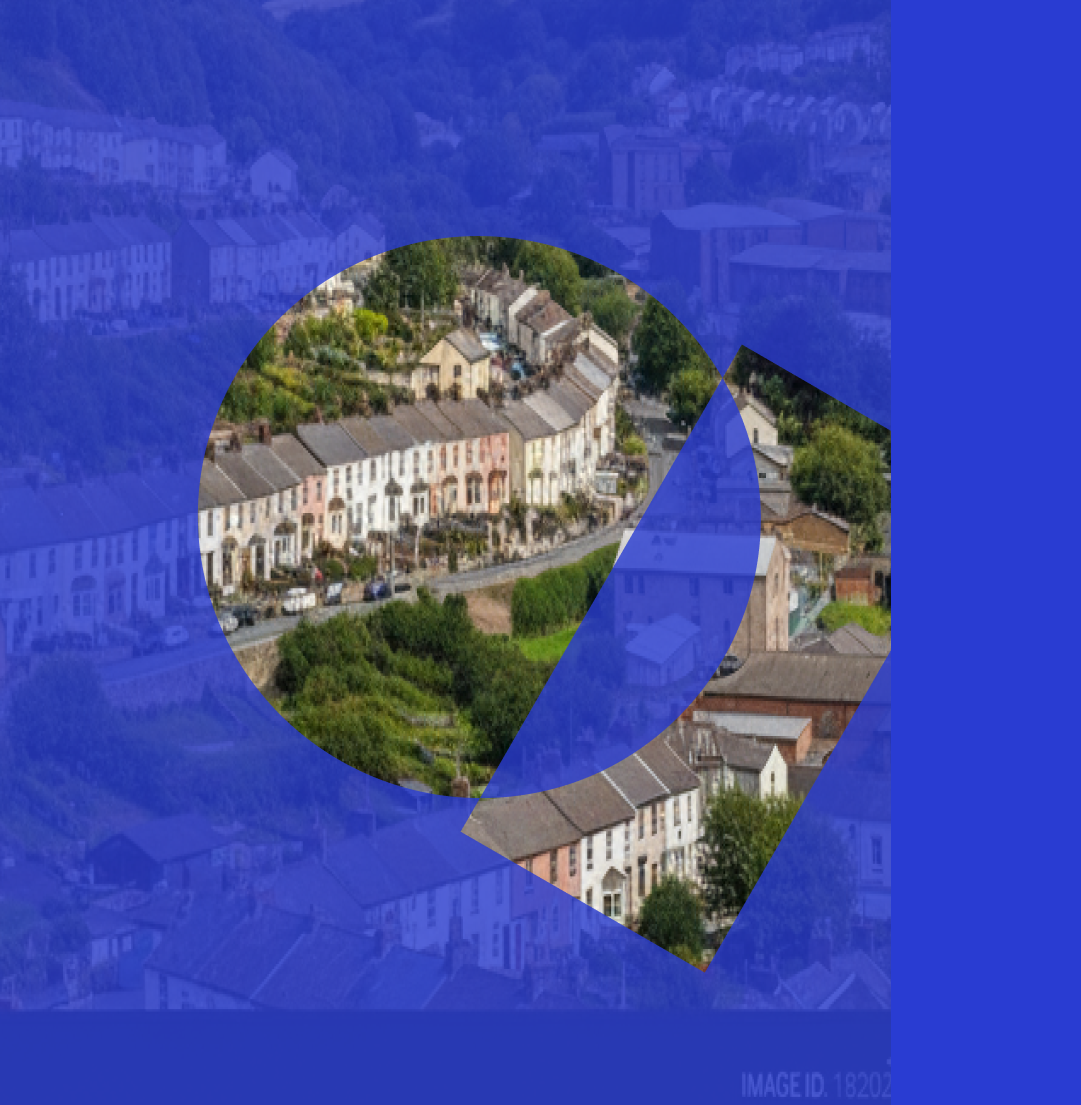COVID-19 has inadvertently enabled us to see what cities with fewer cars can look like. Streets are emptying as non-key workers stay at home. Air pollution halved in the UK in the first day of lockdown alone (Defra) and traffic volumes are down 70% in Italy (INRIX).
Worldwide, cities have been trying to crack down on cars to reduce air pollution and emissions inline with health and climate goals. Sadly it’s taken a global pandemic to make this happen.
Yet with it comes an unprecedented global opportunity to observe the effects of fewer car trips and lower air pollution to put in measures to ensure that, when things go back to normal, we don’t go back to the same habits.

Regent Street, London during Covid-19 lockdown
What’s more, as citizens start to see the benefit of lower air pollution, cities can look to be bolder in future when addressing these issues and draw confidence in the effect of measures they have already planned.
Earlier this year, Birmingham, York and Paris were just some of the major cities to announce intentions to shut at least some streets to private cars. This something we expect to be built on in the times to come.
While cities like Brussels, Rome and Bristol aim to target higher polluters such as diesel with fines or outright bans, others such as York and Oslo are taking more radical steps by aiming to remove cars from city centres altogether.
Methods to achieve this result vary, including shutting streets to vehicles completely as in Leuven, Ghent, and even New York’s Times Square, limiting parking as in Oslo, or ANPR enforcement and fines as in Madrid.
Here’s a snapshot of what cities are implementing in Europe

Want to see what the rest of the world is up to? Take a look at our Carless Cities infographic.
Although initially controversial with businesses and residents alike, once implemented, these measures have proven popular. Take Madrid, whose new mayor vowed to reverse the car ban brought in by his predecessor, only to find himself facing public protest. Rather than reversing it entirely, he has settled for easing the restrictions. As we are already seeing across the world during the pandemic, citizens respond positively to cleaner air.
Yet despite the headlines of the cities planning to transition to “car free” or “carless” long term, few are genuinely banning the car, only private and/or highly polluting cars. To enable the city to continue to function and to ensure accessibility, authorities will still permit loading, emergency vehicles and disabled vehicle access, to name a few.
This means that the vehicle is not going away anytime soon, and neither, therefore, the need to manage vehicle access. The kerb remains a key asset to manage this. Removing cars does not remove kerbside management complexity. When combined with street repurposing, the need for changing traffic regulation, and management of additional use cases, it makes it much more complex.
Already during the pandemic, councils have had to make rapid changes in parking rules. In Seattle, the Mayor has introduced new measures to facilitate kerbside food pick-up, demonstrating a need for dynamic kerb management. The crisis is already revealing what access is most important, including food deliveries, bicycles, NHS workers, and those providing vital services.
At AppyWay, we champion the kerb and empower cities and local authorities to manage and optimise this asset, from managing disabled bays to deliveries. By offering insight into kerb utilisation, we can also help cities meet their social and environmental objectives, for example reallocating kerb space to more sustainable forms of transport such as electric vehicles by determining where to install charging points and prioritising access. This can be done while still enabling businesses to operate and helping to meet freight and servicing needs of growing populations
Ultimately, this will lead to a transition from parking management to kerbside management, and from parking income to kerbside access income. Rather than introducing new pricing structures, kerb access pricing can provide an evolution of already established user charging methods with parking. If we do move towards shared transportation, companies like Uber or future robotaxis can pay to kiss the kerb while picking up or dropping off passengers, opening up revenues for local authorities.
For now, the COVID-19 pandemic makes future policy uncertain as local and national governments pour their resources into responding to the crisis. However, we can also use this pause as a force for good, to make sure we don’t forget that fewer cars on our streets is possible, and be mindful of the benefits. We can observe the impact of this now to help make improved, more informed decisions about managing our kerbs and our streets for the better in future.
If you wish to know more about AppyWay’s initiatives, please do not hesitate to get in touch with our friendly team.






